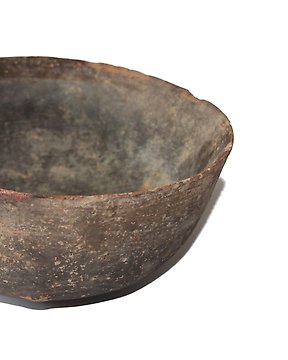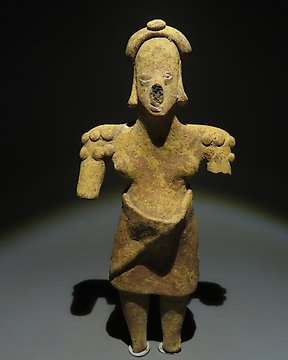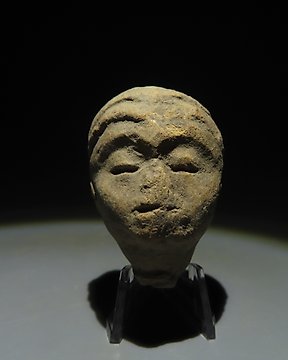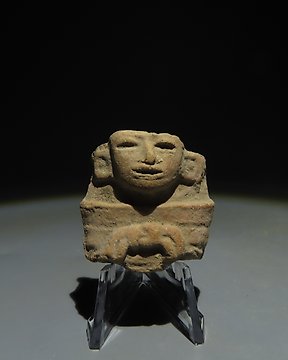Magnifique témoin du passé, envoyé avec tous les justificatifs, impeccable. Encore une fois très satisfait, un grand merci
Voir la traductionTlático Terre cuite Rare tête mythologique. 1200-900 avant JC. "Collection Michel Vinaver". Licence d'importation
Nº 84324369
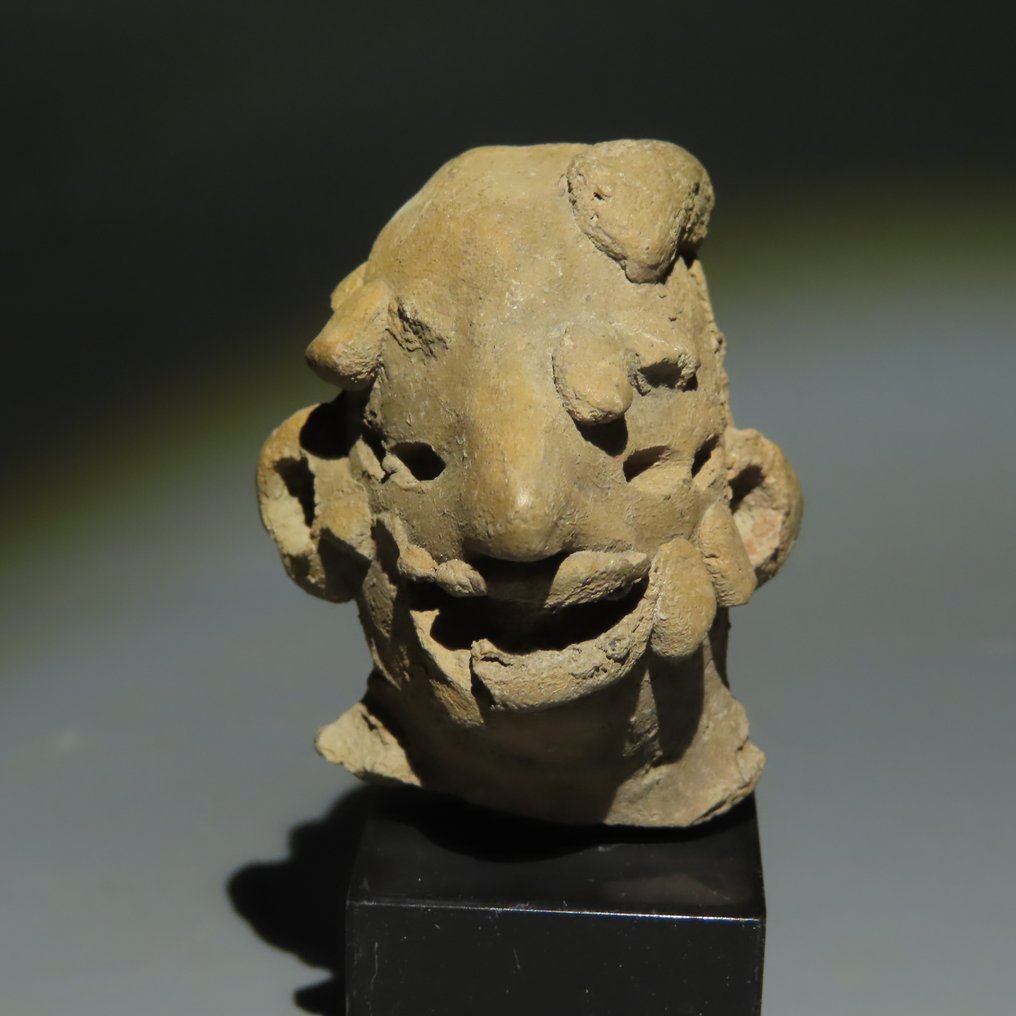

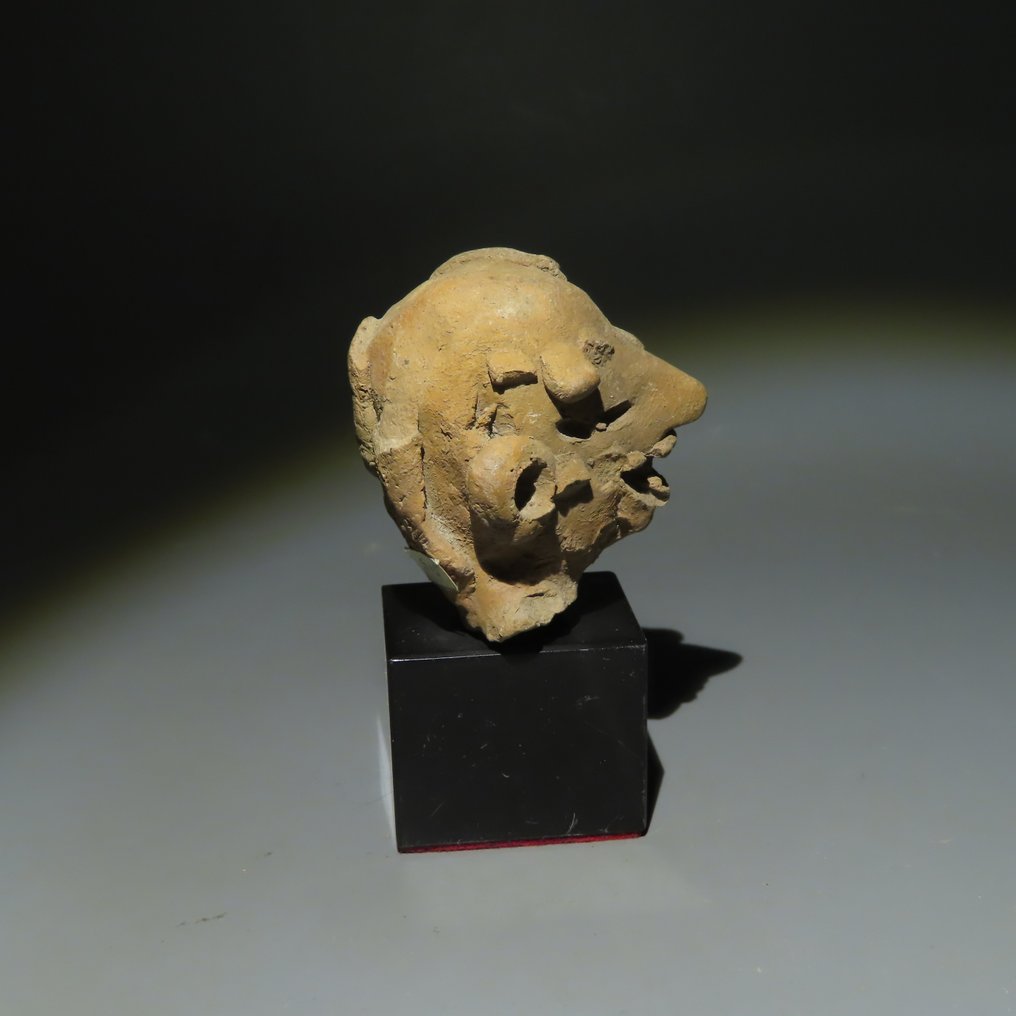
"After all, our present, is also the memory that remains from the past of humanity”.
Said by Michel Vinaver at the interview 9th genuary 2022, at the radio "France Culture".
Rare mythological head from a figure.
CULTURE: Tlatilco,
PERIOD: Early preclasssic, 1200-900 BC.
MATERIAL: Terracotta
DIMENSIONS: Height 5.2 centimeters. 8,3 as mounted on a quality black marble stand.
PROVENANCE:
- Possibly collection of pioneering collector Charles Eugène Espéridion Goupil, 1831-1895. France, possibly acquired from Eugène Boban.
- Collection of Michel Vinaver, French writer and dramatist (Paris 1927-2022)
- Collection established between 1954/55 and 1965 by Michel Vinaver and his brother and listed in France in an inventory carried out on June 21, 1977 by Mr. Paul Brunet, expert at French customs.
- To his clindren, Anouk, Barbara, Delphine and Ivan Vinaver, 2022.
- French art Market, 2022.
CONDITION: Good condition.
Tlatilco, which is the Nahuatl word for "place of hidden things," is an Early Formative period (c. 1200–900 BCE) Mesoamerican site located in the western Valley of Mexico. It consists of three small villages and an extensive cemetery. In the early 20th century, the site was discovered by local miners and instantly attained recognition for its sophisticated archaeological materials. Tlatilco is known for its funerary practices, ceramic vessels, and figurines, most of which date to the site's apogee during the Early Formative period. Tlatilco's pottery vessels include a wide range of types, including animal effigies and many composite and inventive shapes. There are several similarities between Tlatilco materials and those of the Olmec archaeological culture located along the Gulf Coast of Mexico. For instance, a figurine known as "the Acrobat," found in the Tlatilco cemetery among other grave goods, exhibits a theme common in both Olmec and West Mexican art—acrobatic skill and yoga-like poses. Other examples of Tlatilco's Olmec affinities include figurines with wide-open mouths and the common "pretty lady" motif, which I will discuss later. This suggests a strong relationship between these two groups and the diverse cultures characterizing the Formative period in Mesoamerica.
Tlatilco's sculptures show a reverence for bonding, nurturing, and fertility traits associated predominantly with women. Tlatilco's artisans made figurines solely by hand, mastering shaping and pinching techniques to create these elaborate pieces without the use of molds.
The extraordinary precision it takes to sculpt motifs and fine details in such a small amount of space—most figures are only up to 15 cm tall—reveals the talent and skill held by the people of Tlatilco.
Sculpted some three millennia ago in the Valley of Mexico, this figurine belongs to a group of ceramic effigies known collectively as the Tlatilco "pretty ladies." Depicting females with large heads, small waists, and prominent hips, these handheld sculptures present a fairly standardized body type and are typically fired to red, buff, or brown tones. As the popular embodiments of an ideal feminine form, the Tlatilco "pretty ladies" are part of a centuries-long tradition in which eccentricities and religious imagery predominate. Featuring hunchbacks, dwarfs, contorted acrobats, two-headed women, and conjoined twins, the corpus of Tlatilco figurines encompasses the full gamut of human representation.
For generations, Tlatilco was a small farming community located on the fringes of modern-day Mexico City. By the early twentieth century, however, the fields of clay surrounding Tlatilco had become important sites of brick production utilized in the construction and rapid expansion of the nearby Federal District. In 1936, brick workers began unearthing troves of ceramic figurines—later termed "pretty ladies"—that closely resembled others recently discovered by the archaeologist George C. Vaillant (1930). Using what little contextual information he had available to him, Vaillant accurately attributed these works to the Early to Middle Preclassic-period Zacatenco culture (ca. 1500–600 B.C.)--an umbrella term which also included the people of Tlatilco.
Beginning in the 1940s, archaeologists began to study the site of Tlatilco in earnest. Led by the renowned artist, ethnologist, and art historian Miguel Covarrubias, federally funded excavations helped to expose hundreds of ancient burials containing not only "pretty lady" figurines but also rich collections of polychrome pottery, carved jade, and stone tools. The enormous number of durable, finely made objects enabled Covarrubias to establish a more comprehensive typology of Tlatilco works than was previously possible. Through his comparisons of the local ceramic tradition with that of the contemporary Olmec culture, Covarrubias (1957) was able to document a large-scale incursion of Gulf Coast peoples into the area of Tlatilco sometime during the Late Preclassic period (ca. 600 B.C.). As a result, scholars now recognize the Tlatilco people as central players in the interregional, multi-ethnic cultural exchange that came to characterize Central Mexican Highland cultural interactions for the next several centuries.
Provenance:
Michel Vinaver (born Michel Grinberg; 13 January 1927) is a French writer and dramatist. He was born in Paris to parents who had emigrated from Russia. He is the father of actress Anouk Grinberg. In 2006 he was awarded the Grand prix du théâtre de l'Académie française.
Vinaver, perhaps to differentiate this activity from his work as a top executive at the Gillette house, was its general director between 1966 and 1982, a post he left to become a professor of theater studies at the University of Paris III and later in Paris VIII, until his retirement -, he began to publish works – The Lataume novels in 1950 and The objector in 1952 – while he became friends, through the mail, with Albert Camus. A friend from work introduced him to the theater in 1954 and from then on he began to explore dramatic writing until he became one of the essential names in French dramaturgy. Since The Koreans, from 1955, premiered by Robert Planchon, Vinaver's writing has regularly hit the stage. Serreau, Vitez, Francon will work on his texts in the following years. His work is not abundant, about thirty plays, which he writes over half a century. Always attentive to the world around him, he becomes a lucid witness of the second part of the 20th century.
Additional Provenance "Eugène Goupil".
Some of the objects have attached a tag of the Eugène Goupil collection. We know that some of remains of the Goupil collection went into the french art market
Charles Eugène Espéridion Goupil (December 14, 1831, Mexico - October 24, 1895), is a French businessman, philanthropist and collector of Franco-Mexican origin. He acquired an important collection of antiquities and Mexican manuscripts or printed documents and donated the last to the Bibliotèque National de France, making the Mexican collection of this institution one of the most important in the world. The Trocadéro ethnography museum also inherited some of his pieces.
Driven by the desire to preserve and publicize the heritage of "his Indian ancestors" "in authentic form", he vows to build a collection for the benefit of science. In 1888, he bought the collection of antiquities from the antiquities dealer Eugène Boban, which he lent to him for the World's Fair of 1889. Through Boban, in 1889 he acquired a large number of manuscripts and rare engravings by Joseph Marius Alexis Aubin. The latter had in his time acquired many pieces from the Boturini collection, confiscated by the viceroy of New Spain. He had brought his collection to France in 1840 and put it up for sale at the end of the century due to financial difficulties. Boban drew up the catalog of his collection, which appeared in 1891, and undertook the publication of certain manuscripts.
In accordance with his wishes, his widow donated the best part of the collection to the Bibliotèque National de France in 1898. Part of the Boban collection was donated to the Trocadéro ethnographic museum. The Goupil family kept antiques and documents of minor importance, which will be sold until at least the middle of the 20th century and they are the ones that where acquired by Michel Vinaver and now sold here.
Eugène Boban:
Eugène Goupil in 1888 bought the collection of antiquities from the antiquities dealer Eugène Boban and the type of the tag present in our piecea is very similar to the ones used by Eugène Boban and therefore our collection is possibly comming from Eugène Boban collection that was sold to Goupil.
Eugène Boban or Boban-Duvergé (1834–1908) was a French antiquarian. He was the official archaeologist of the court of Maximilian I of Mexico, and a member of the French Scientific Commission in Mexico. From time to time he sold crystal skulls, one which is now in the Musée du Quai Branly and another in the British Museum. In 1891, he organized and published the Aubin-Goupil Collection of manuscripts, bought in 1889 by Eugène Goupil and now in the Bibliothèque nationale. Ethnological objects from his collection were sold at Paris in 1908.
Notes:
- The piece includes authenticity certificate.
- The piece includes Spanish Export License (Passport for European Union) - If the piece is destined outside the European Union a substitution of the export permit should be requested, can take between 1-2 weeks maximum.
- The seller guarantees that he acquired this piece according to all national and international laws related to the ownership of cultural property. Provenance statement seen by Catawiki.
À propos du vendeur
"After all, our present, is also the memory that remains from the past of humanity”.
Said by Michel Vinaver at the interview 9th genuary 2022, at the radio "France Culture".
Rare mythological head from a figure.
CULTURE: Tlatilco,
PERIOD: Early preclasssic, 1200-900 BC.
MATERIAL: Terracotta
DIMENSIONS: Height 5.2 centimeters. 8,3 as mounted on a quality black marble stand.
PROVENANCE:
- Possibly collection of pioneering collector Charles Eugène Espéridion Goupil, 1831-1895. France, possibly acquired from Eugène Boban.
- Collection of Michel Vinaver, French writer and dramatist (Paris 1927-2022)
- Collection established between 1954/55 and 1965 by Michel Vinaver and his brother and listed in France in an inventory carried out on June 21, 1977 by Mr. Paul Brunet, expert at French customs.
- To his clindren, Anouk, Barbara, Delphine and Ivan Vinaver, 2022.
- French art Market, 2022.
CONDITION: Good condition.
Tlatilco, which is the Nahuatl word for "place of hidden things," is an Early Formative period (c. 1200–900 BCE) Mesoamerican site located in the western Valley of Mexico. It consists of three small villages and an extensive cemetery. In the early 20th century, the site was discovered by local miners and instantly attained recognition for its sophisticated archaeological materials. Tlatilco is known for its funerary practices, ceramic vessels, and figurines, most of which date to the site's apogee during the Early Formative period. Tlatilco's pottery vessels include a wide range of types, including animal effigies and many composite and inventive shapes. There are several similarities between Tlatilco materials and those of the Olmec archaeological culture located along the Gulf Coast of Mexico. For instance, a figurine known as "the Acrobat," found in the Tlatilco cemetery among other grave goods, exhibits a theme common in both Olmec and West Mexican art—acrobatic skill and yoga-like poses. Other examples of Tlatilco's Olmec affinities include figurines with wide-open mouths and the common "pretty lady" motif, which I will discuss later. This suggests a strong relationship between these two groups and the diverse cultures characterizing the Formative period in Mesoamerica.
Tlatilco's sculptures show a reverence for bonding, nurturing, and fertility traits associated predominantly with women. Tlatilco's artisans made figurines solely by hand, mastering shaping and pinching techniques to create these elaborate pieces without the use of molds.
The extraordinary precision it takes to sculpt motifs and fine details in such a small amount of space—most figures are only up to 15 cm tall—reveals the talent and skill held by the people of Tlatilco.
Sculpted some three millennia ago in the Valley of Mexico, this figurine belongs to a group of ceramic effigies known collectively as the Tlatilco "pretty ladies." Depicting females with large heads, small waists, and prominent hips, these handheld sculptures present a fairly standardized body type and are typically fired to red, buff, or brown tones. As the popular embodiments of an ideal feminine form, the Tlatilco "pretty ladies" are part of a centuries-long tradition in which eccentricities and religious imagery predominate. Featuring hunchbacks, dwarfs, contorted acrobats, two-headed women, and conjoined twins, the corpus of Tlatilco figurines encompasses the full gamut of human representation.
For generations, Tlatilco was a small farming community located on the fringes of modern-day Mexico City. By the early twentieth century, however, the fields of clay surrounding Tlatilco had become important sites of brick production utilized in the construction and rapid expansion of the nearby Federal District. In 1936, brick workers began unearthing troves of ceramic figurines—later termed "pretty ladies"—that closely resembled others recently discovered by the archaeologist George C. Vaillant (1930). Using what little contextual information he had available to him, Vaillant accurately attributed these works to the Early to Middle Preclassic-period Zacatenco culture (ca. 1500–600 B.C.)--an umbrella term which also included the people of Tlatilco.
Beginning in the 1940s, archaeologists began to study the site of Tlatilco in earnest. Led by the renowned artist, ethnologist, and art historian Miguel Covarrubias, federally funded excavations helped to expose hundreds of ancient burials containing not only "pretty lady" figurines but also rich collections of polychrome pottery, carved jade, and stone tools. The enormous number of durable, finely made objects enabled Covarrubias to establish a more comprehensive typology of Tlatilco works than was previously possible. Through his comparisons of the local ceramic tradition with that of the contemporary Olmec culture, Covarrubias (1957) was able to document a large-scale incursion of Gulf Coast peoples into the area of Tlatilco sometime during the Late Preclassic period (ca. 600 B.C.). As a result, scholars now recognize the Tlatilco people as central players in the interregional, multi-ethnic cultural exchange that came to characterize Central Mexican Highland cultural interactions for the next several centuries.
Provenance:
Michel Vinaver (born Michel Grinberg; 13 January 1927) is a French writer and dramatist. He was born in Paris to parents who had emigrated from Russia. He is the father of actress Anouk Grinberg. In 2006 he was awarded the Grand prix du théâtre de l'Académie française.
Vinaver, perhaps to differentiate this activity from his work as a top executive at the Gillette house, was its general director between 1966 and 1982, a post he left to become a professor of theater studies at the University of Paris III and later in Paris VIII, until his retirement -, he began to publish works – The Lataume novels in 1950 and The objector in 1952 – while he became friends, through the mail, with Albert Camus. A friend from work introduced him to the theater in 1954 and from then on he began to explore dramatic writing until he became one of the essential names in French dramaturgy. Since The Koreans, from 1955, premiered by Robert Planchon, Vinaver's writing has regularly hit the stage. Serreau, Vitez, Francon will work on his texts in the following years. His work is not abundant, about thirty plays, which he writes over half a century. Always attentive to the world around him, he becomes a lucid witness of the second part of the 20th century.
Additional Provenance "Eugène Goupil".
Some of the objects have attached a tag of the Eugène Goupil collection. We know that some of remains of the Goupil collection went into the french art market
Charles Eugène Espéridion Goupil (December 14, 1831, Mexico - October 24, 1895), is a French businessman, philanthropist and collector of Franco-Mexican origin. He acquired an important collection of antiquities and Mexican manuscripts or printed documents and donated the last to the Bibliotèque National de France, making the Mexican collection of this institution one of the most important in the world. The Trocadéro ethnography museum also inherited some of his pieces.
Driven by the desire to preserve and publicize the heritage of "his Indian ancestors" "in authentic form", he vows to build a collection for the benefit of science. In 1888, he bought the collection of antiquities from the antiquities dealer Eugène Boban, which he lent to him for the World's Fair of 1889. Through Boban, in 1889 he acquired a large number of manuscripts and rare engravings by Joseph Marius Alexis Aubin. The latter had in his time acquired many pieces from the Boturini collection, confiscated by the viceroy of New Spain. He had brought his collection to France in 1840 and put it up for sale at the end of the century due to financial difficulties. Boban drew up the catalog of his collection, which appeared in 1891, and undertook the publication of certain manuscripts.
In accordance with his wishes, his widow donated the best part of the collection to the Bibliotèque National de France in 1898. Part of the Boban collection was donated to the Trocadéro ethnographic museum. The Goupil family kept antiques and documents of minor importance, which will be sold until at least the middle of the 20th century and they are the ones that where acquired by Michel Vinaver and now sold here.
Eugène Boban:
Eugène Goupil in 1888 bought the collection of antiquities from the antiquities dealer Eugène Boban and the type of the tag present in our piecea is very similar to the ones used by Eugène Boban and therefore our collection is possibly comming from Eugène Boban collection that was sold to Goupil.
Eugène Boban or Boban-Duvergé (1834–1908) was a French antiquarian. He was the official archaeologist of the court of Maximilian I of Mexico, and a member of the French Scientific Commission in Mexico. From time to time he sold crystal skulls, one which is now in the Musée du Quai Branly and another in the British Museum. In 1891, he organized and published the Aubin-Goupil Collection of manuscripts, bought in 1889 by Eugène Goupil and now in the Bibliothèque nationale. Ethnological objects from his collection were sold at Paris in 1908.
Notes:
- The piece includes authenticity certificate.
- The piece includes Spanish Export License (Passport for European Union) - If the piece is destined outside the European Union a substitution of the export permit should be requested, can take between 1-2 weeks maximum.
- The seller guarantees that he acquired this piece according to all national and international laws related to the ownership of cultural property. Provenance statement seen by Catawiki.
À propos du vendeur
- 746
- 6
- 0
Thank you for the Special offer and the fast shipping of this excellent piece of art!
Voir la traductionvery good description of the object, very good price for this rare item,. Fast sending (has been at my place 2 days after buying!). Definitely would buy again.
Voir la traductionSehr schön
Voir la traductionAs described, perfect logistic
Voir la traductiongreat seller, everything came as should with certificate of authenticity
Voir la traductionExceptionally well packaged, description aligned with positing received
Voir la traductionReally precious, but without sound...
Voir la traductionPainting well packed and rapidly sent!
Voir la traductionsempre grande rapidità e professionalità
Voir la traductionparfait bien reçu, merci
Voir la traductionVery satisfied with the small Greek Lekythos. As always (we have already bought several items from Bagot), the object was wrapped and sent immediately and with the greatest care.
Voir la traductionPerfect, excellent condition, good packaging, the parcel arrived without any problems… all is perfect as usual. Thank you very much and wait for an other nice piece like this one. Gilles.
Voir la traduction+++ Top vendeur professionnel comme d'habitude
Voir la traductionEmbora o custo de transporte esteja acima da média foi, realmente, muito bem executado e em embalagem cuidada. Expeditos e profissionais. Recomendo
Voir la traductionSnel en correct en goed verpakt verzonden
Voir la traductionoggetto bellissimo, fedele alla descrizione, venditore affidabile
Voir la traductionVery nice piece and fast delivery
Voir la traductionEverything ok, top seller! Thank you again!
Voir la traductionvery beautiful and fast shipping!thank you!
Voir la traductionExcelent, very good piece++++
Voir la traductionVendedor increíble muy buenos he comprado muchas veces todo perfecto. Muchas gracias
Voir la traductionpas de problème ; merci beaucoup
Voir la traductiontres rapide conforme hope next +++
Voir la traductionSehr schön! Vielen Dank!
Voir la traduction- 746
- 6
- 0
Magnifique témoin du passé, envoyé avec tous les justificatifs, impeccable. Encore une fois très satisfait, un grand merci
Voir la traductionMentions légales
Le vendeur garantit que l'objet a été obtenu légalement et est en mesure de le prouver. Le vendeur a été informé par Catawiki qu'il devait fournir les documents requis par les dispositions législatives et réglementaires de son pays de résidence. Le vendeur garantit qu’il est autorisé à vendre/exporter cet objet. Le vendeur fournira à l'acheteur toutes les informations connues sur la provenance de l'objet. Le vendeur veillera à ce que tous les permis nécessaires soient (déjà) obtenus. Le vendeur informera immédiatement l'acheteur en cas de retard dans l'obtention de ces permis.
Le vendeur garantit que l'objet a été obtenu légalement et est en mesure de le prouver. Le vendeur a été informé par Catawiki qu'il devait fournir les documents requis par les dispositions législatives et réglementaires de son pays de résidence. Le vendeur garantit qu’il est autorisé à vendre/exporter cet objet. Le vendeur fournira à l'acheteur toutes les informations connues sur la provenance de l'objet. Le vendeur veillera à ce que tous les permis nécessaires soient (déjà) obtenus. Le vendeur informera immédiatement l'acheteur en cas de retard dans l'obtention de ces permis.
